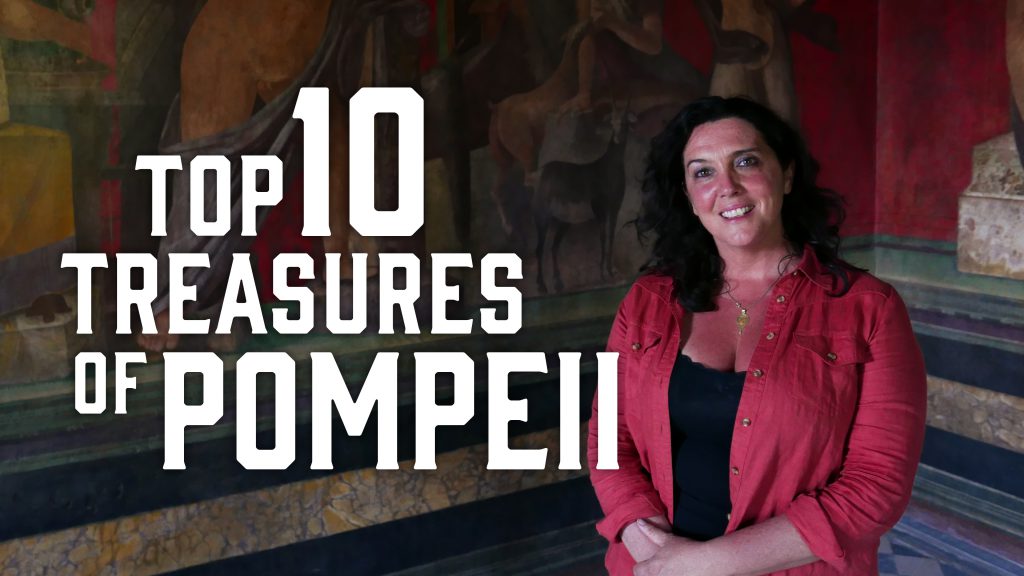Secrets of Pompeii’s Greatest Treasures episode 1: Bettany Hughes heads to the Ancient Roman City of Pompeii. Once compounded by volcanic ash, now a treasure trove of history. Almost 2,000 years on, Bettany explores the city to find remnants of the Roman empire, revealing the secrets of those who lived there, and really how different ancient Rome is to our world today. Exploring the villas usually off-limits to the public and the chilling remains of those that tried to escape the eruption of Mount Vesuvius in 79AD, Bettany builds up a perhaps not so idyllic picture of life in Pompeii all those years ago.
Among some of the treasures, is the world-famous “masterpiece”, the Cave Canem ‘beware of the dog’ mosaic, one of the most imitated and celebrated artworks in the world. We also establish the importance of animals to the ancient Romans, as pets but also as guard dogs, just like we have today.. By carefully examining bones of 113 dogs and comparing them with the results of the mosaics, researchers have been able to piece together the identity of the canine guards in Pompeii.
Bettany also tells viewers that while Pompeii was luxurious and civilised place to live, crime was also extremely common, so much so that people often didn’t go out at night, for fear of being in danger .
Secrets of Pompeii’s Greatest Treasures episode 1
Pompeii was an ancient city located in what is now the comune of Pompei near Naples in the Campania region of Italy. Pompeii, along with Herculaneum and many villas in the surrounding area (e.g. at Boscoreale, Stabiae), was buried under 4 to 6 m (13 to 20 ft) of volcanic ash and pumice in the eruption of Mount Vesuvius in AD 79.
Largely preserved under the ash, the excavated city offered a unique snapshot of Roman life, frozen at the moment it was buried, although much of the detailed evidence of the everyday life of its inhabitants was lost in the excavations. It was a wealthy town, with a population of ca. 11,000 in AD 79, enjoying many fine public buildings and luxurious private houses with lavish decorations, furnishings and works of art which were the main attractions for the early excavators. Organic remains, including wooden objects and human bodies, were entombed in the ash. Over time, they decayed, leaving voids which archaeologists found could be used as moulds to make plaster casts of unique, and often gruesome, figures in their final moments of life.
The numerous graffiti carved on the walls and inside rooms provide a wealth of examples of the largely lost Vulgar Latin spoken colloquially at the time, contrasting with the formal language of the classical writers. Pompeii is a UNESCO World Heritage Site and is one of the most popular tourist attractions in Italy, with approximately 2.5 million visitors annually. After many excavations prior to 1960 that had uncovered most of the city but left it in decay, further major excavations were banned and instead they were limited to targeted, prioritised areas. In 2018, these led to new discoveries in some previously unexplored areas of the city.
Bettany Hughes
Professor Bettany Hughes is an award-winning historian, author and broadcaster, who has devoted the last 25 years to the vibrant communication of the past. Her speciality is ancient and mediaeval history and culture. A Scholar at Oxford University she has taught at Oxford and Cambridge Universities and lectured at Cornell, Bristol, UCL, Maastricht, Utrecht, Manchester and Swansea. She is a Tutor for Cambridge University’s Institute of Continuing Education, a Research Fellow of King’s College London and recently joined the New College of the Humanities as Professor of History.
Bettany Hughes first book Helen of Troy: Goddess, Princess, Whore has been translated into ten languages. Her second, The Hemlock Cup, Socrates, Athens and the Search for the Good Life was a New York Times bestseller and was shortlisted for the Writer’s Guild Award. Her latest book Istanbul – A Tale of Three Cities was shortlisted for the Runciman Award and was a Sunday Times bestseller. Istanbul A Tale of Three Cities has already been translated into twelve languages. She has written and presented over 50 TV and radio documentaries for the BBC, Channel 4, Netflix, Discovery, PBS, The History Channel, National Geographic, BBC World and ITV. Her programmes have now been seen by over 250 million worldwide.




